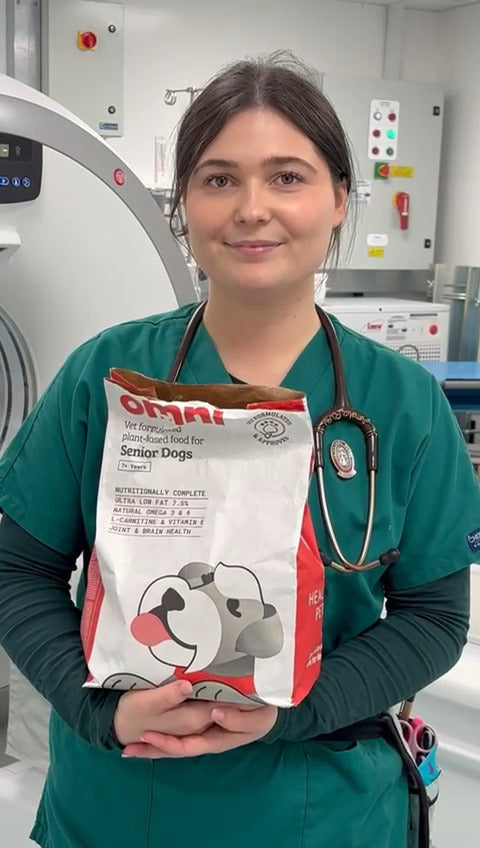How Can I Stop My Dog Barking?

Paula, 50, from Surrey would like her dog Tom to stop barking constantly.
Unfortunately, it’s not always as simple as asking nicely. Barking can drive many dog guardians up the wall with frustration as they try to enjoy a quiet night in.
Thankfully, it is something that you and your dog can overcome by working together and using some of the tips from Omni’s vets.
In this article, Omni’s co-founder and Chief Vet Dr Guy Sandelowsky will tell you exactly how you should overcome your dog’s constant barking which is, most of the time, a response to fear or anxiety.
Reasons Why Your Dog is Barking
Firstly, it is important to remember that barking is a completely normal behaviour that almost all dogs do. A dog who never barks is like a person who never talks; it suggests there is something not quite right with your dog!
That said, a few breeds of dogs never bark (including Bernese mountain dogs and Great Danes, due to their lung size) - but for most, barking is a normal part of communication, alongside body language and facial expressions.
On the flip side, though, a dog who barks constantly - like a person who talks constantly - may well be showing signs of underlying chronic anxiety.
The best person to understand the underlying causes behind your dog’s barking is actually you, the guardian, as you spend the most time with them.
Next time your dog starts barking, rather than getting frustrated with them, try and figure out what they are barking at. Follow their eyes and try to see what they are looking at, or think back to what happened when the barking started.
Factors that commonly set dogs off barking are:
- Strangers: Dogs often bark at unfamiliar people approaching the house or walking by, as they perceive them as potential threats.
- Other Dogs: Whether it's across the street, in the park, or on TV, many dogs bark at other dogs, either out of excitement, territoriality, or fear.
- Doorbells or Knocking: The sound of a doorbell or someone knocking is a common trigger for barking, as it signals the arrival of a visitor. This could also simply be on the TV or in a video, but your dog thinks it’s your door!
- Squirrels or Small Animals: Many dogs have a strong prey drive and will bark at squirrels, birds, rabbits, or other small creatures they see outside.
- Noises: Unexpected or loud noises, like fireworks, thunderstorms, car alarms, or construction sounds, often cause dogs to bark due to fear or anxiety.
- Vehicles: Some dogs bark at moving vehicles, such as cars, bikes, or motorcycles, as they perceive them as fast-moving threats that may crash into you or them. (Remember - dogs don’t necessarily understand cars!)
- People Walking By: Dogs, especially those near windows or in fenced yards, may bark at people walking past their territory as a way to warn them to stay away.
- Delivery People (Mail carriers, etc.): Dogs often bark at delivery people, such as mail carriers or couriers, because they perceive them as intruders into their territory.
- Other Pets: Dogs may bark at household pets like cats, especially during moments of excitement, play, or if they feel their territory is being invaded.
- Loneliness or Boredom: When left alone for extended periods, dogs may bark excessively as a way of expressing loneliness, boredom, or separation anxiety.
- Communication: Dogs can also bark because they need the toilet, a toy is stuck under the sofa, or because they are tired or in pain. If they are trying to let you know something, chances are they’ll start barking about it!
Once you have identified the trigger that starts your dog barking, you need to be able to desensitise them to it.
How to Desensitise Your Dog and Stop Them Barking
This method involves gradually increasing your dog's exposure to the trigger (e.g., vacuum cleaners, fireworks or postmen) in a safe manner.
To do this you start with doing only the first part of the trigger and rewarding them if they make no response to it.
In the vacuum example, this would mean regularly starting the action of opening the cupboard or plugging in the vacuum (reaching a point just before there is a reaction) then rewarding the dog if they do not react.
Gradually over time you should be able to get slightly further with the action with no response, such as starting to drive the vacuum around the room without the power on.
The same technique can be used to reduce reactivity to fireworks: simply start playing firework noises very quietly for short periods then gradually increase your dog’s exposure.
It is important to remember that this method requires your dog to be in a calm and safe environment and takes a lot of patience and practice with them. You cannot rush it, as your dog will not make the progress you both want!
You could also try creating a ‘Quiet Cue’ with your dog.
What Is a Quiet Cue, and How Do I Train My Dog to Be Quiet?
A quiet cue is a sign you give your dog that they should be quiet.
To start training a quiet cue, you can utter a simple command - like “Quiet” - just after your dog has stopped barking.
Many behaviourists and trainers will pair this with a “Bark!” or “Speak!” command which they use while the dog is barking. This helps to highlight the difference between “Bark” and “Quiet”, meaning the latter is followed more closely.
After using the quiet cue, you can give them a treat for being quiet.
With practice, you should be able to start saying the quiet cue during barking (or perhaps when barking is tapering off) and then rewarding your dog for being quiet after you have said “Quiet”.
Again, this takes a while to train into your dog, but once your dog has learned their quiet cue, you should be able to use it in any situation, provided you have your dog’s attention!
How Can I Distract My Dog and Stop Them Barking?
Distracting your dog from their trigger can be another way to stop them from barking.
For example, something much more interesting than whatever it is that is making them bark could be their favourite toy or a play session with their favourite person (you!).
This can also reassure them that everything is alright and they do not need to worry or guard their territory from strange invaders - especially if they see that you are perfectly happy and not showing signs of frustration or worry.
Should I Punish My Dog For Barking?
No. As vets and dog guardians, we are big advocates for positive reinforcement rather than negative reinforcement.
What that means is that we advocate for rewarding your dog for good behaviours, rather than punishing them for bad ones.
It can be frustrating being a dog guardian, but - like being a parent to a human child - it is both a duty and a responsibility for you to raise your fur baby as well as you can and set them up for success in the future.
Not to mention the fact that punishing your dog when they are already anxious can just prove to them that they are right to be anxious and thereby further entrench the behaviour!
Dogs generally do not understand why they are being punished, but they do understand rewards - especially the tasty kind.
Can I Use Supplements to Reduce My Dog’s Anxiety?
Many dog parents report that calming supplements can make a difference with overall demeanour and behavioural responses.
For example, Omni’s ‘Stress & Anxiety’ supplement contains safe, natural and effective compounds like L-tryptophan, Passionflower, and L-theanine in order to support your dog’s peace of mind.
How Does L-Tryptophan Prevent My Dog From Barking?
L-tryptophan is an essential amino acid that helps in the production of serotonin, a neurotransmitter that regulates mood, sleep, and feelings of well-being.
By increasing serotonin levels, L-tryptophan can promote relaxation, reduce anxiety, and help with aggression or excessive barking in dogs. It's often used to calm dogs in stressful situations like travel, thunderstorms, or separation anxiety.
By reinforcing calmness through serotonin production, Omni’s vets believe that their Stress & Anxiety supplement can help calm your dog down and prevent excessive barking.
How Does Passionflower Prevent My Dog From Barking?
Passionflower is a plant known for its sedative properties. It affects the GABA (gamma-aminobutyric acid) system in the brain, which helps reduce nervous activity and promotes relaxation.
It’s commonly used to help dogs manage anxiety, hyperactivity, and stress. Passionflower can be helpful for calming dogs in anxious situations, reducing fear-based behaviours, and improving sleep quality.
How Does L-Theanine Prevent My Dog From Barking?
Like L-tryptophan, L-theanine is an amino acid, but this one is found in green tea and is the active ingredient that promotes relaxation without causing drowsiness. It increases dopamine and serotonin levels while enhancing GABA production, which all contribute to a calming effect.
L-theanine is used to reduce anxiety and promote a calm, focused demeanour in dogs, particularly in situations like loud noises, new environments, or general stress.
When to Contact a Vet
You should contact a vet if:
- Your dog is barking lots without an obvious reason, such as one of the triggers listed above.
- Barking is accompanied by other worrisome behaviours or symptoms like pain, weight loss, or loss of coordination.
- You’re concerned about your dog’s behaviour, but you’re unsure if it requires emergency care.
You may also wish to contact a local dog behaviourist - just be sure to check they are professionally qualified and have positive client reviews.
If you’re worried about your dog’s health, it’s always best to get professional advice. Book a free consultation with our vet team at Omni for expert guidance on what could be causing your dog’s excessive panting and how to manage it.
Thoughts from Dr Guy MRCVS
As dog lovers and guardians, it’s natural to worry about our furry friends, especially when they display abnormal symptoms that can’t be easily explained. That’s why, when I founded Omni, I knew that I wanted to keep vet consultation free and accessible at the heart of the business.
If you’re understandably worried about your dog, but you don’t think you need to take them to the vets urgently, I highly recommend getting some friendly, professional advice from one of our team.
Explore some of the frequently asked questions in our Ask a Vet series
Got a question for the Ask a Vet team?
Submit your question via email to woof@omni.pet. We’ll get back to you as soon as we can, and, if suitable, post the response here to help others, too!
Disclaimer: Our Video Vet Consultation service is limited because we are unable to perform a full physical examination of your pet. Our vets have no responsibility for the examination or other medical services provided during the Consultation.
Please note that our Video Vet Consultations do not replace traditional veterinary care, but can provide additional support. Based on the information you have provided and the symptoms you have described, the Vet will give you advice and an ongoing plan. Without a physical examination, we cannot provide a definitive diagnosis. If you are worried that your dog's condition is worsening, or you need additional support, please schedule another consultation, or see your registered vet.







 85 Great Portland Street, 1st Floor, London, W1W 7LT United Kingdom
85 Great Portland Street, 1st Floor, London, W1W 7LT United Kingdom